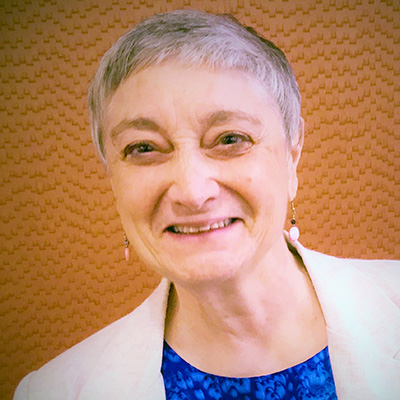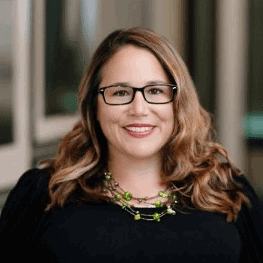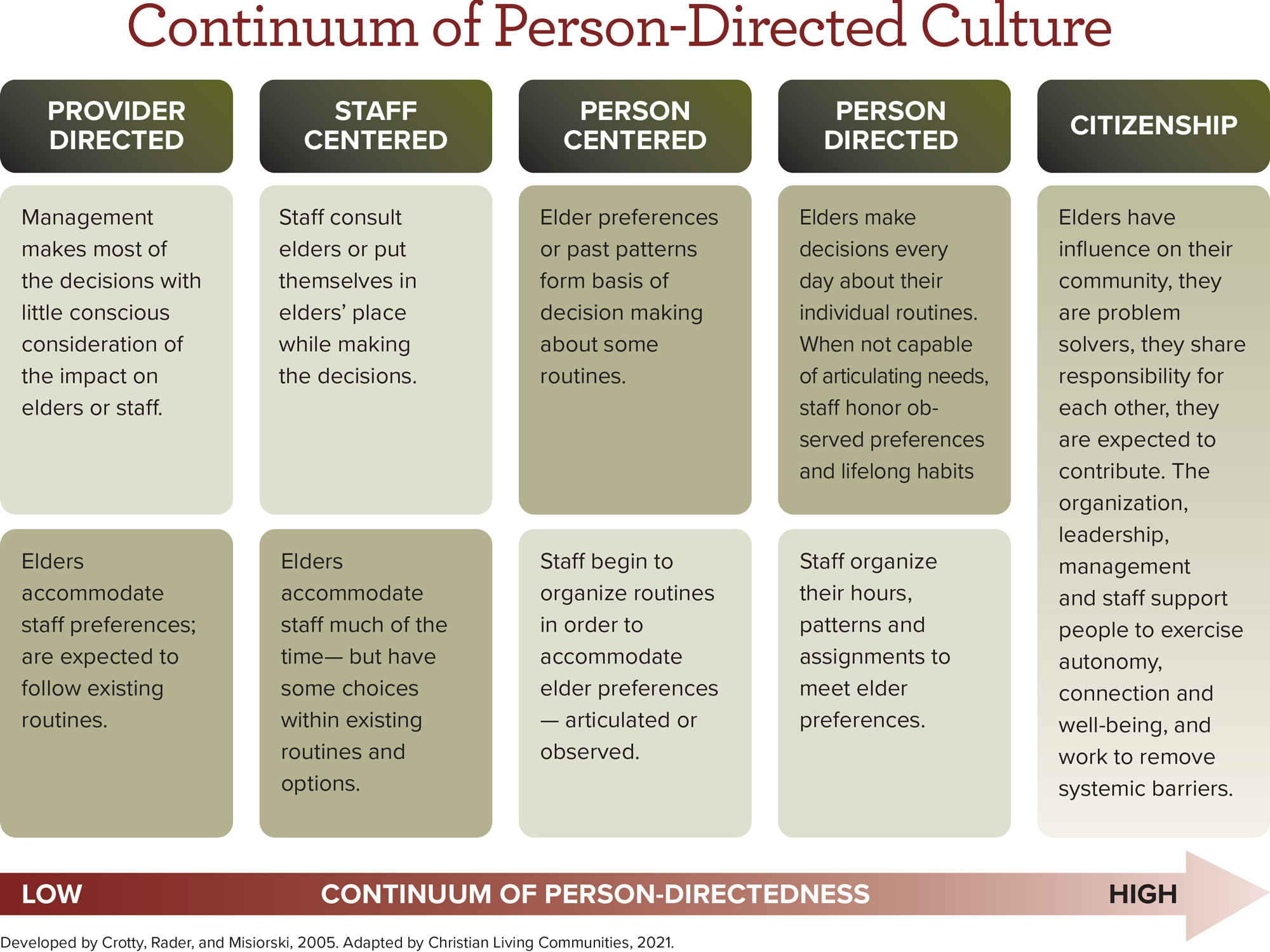Verna Cavey, Resident, Independent Living, Christian Living Communities
Moriah Bernhardt, Senior Director of Rhythms Programs for CLC-Cappella

Verna Cavey
We were just going to write a garden-variety article and then decided it would be better if we bounced some ideas around with you — our colleagues who have years of experience and whose insights we trust.
We (Moriah and Verna) have recently presented at several state conferences and are preparing for a national presentation. And every time our audience has reshaped our thinking and our questions. Our “presentation” became instead an invigorating collaboration with insightful folks in the aging field.
The subject is resident-driven or resident-directed communities, or take it to the next level of resident citizenship. (In her book, Disrupting the Status Quo of Senior Living – A Mindset, Jill Vitale-Aussem refers to “citizenship” in community). In other words, residents are no longer perceived as customers or consumers, but rather active citizens of the community, and staff are not seen as “serving” the residents.

Moriah Bernhardt
There is no textbook on this, nor is there a neat list of resident-directed communities. We have only our very positive experience to guide us. And yet, when we talked to conference participants, we too often heard that resident-directed communities are difficult and too scary to create. So we ask you:
- “What are the obstacles which get in the way of creating these communities?
- What resources or information about resident-driven communities are needed? What resources have you found which have been helpful to you?
- Do you know of a community which you feel has the characteristics of a resident-driven community?
In a conversation with Joanne Rader, one of the founders of Pioneer Network, she explained that the philosophy of resident-driven communities has been taught and practiced for 50 years. “Why,” she asked, “has it taken so long to make it a reality?” Her concerns echo ours and we couldn’t stay quiet any longer.
Recently, we listened to an interview with Cameron Camp who spoke about resident-driven communities (in his Montessori work in dementia care) and stated, “it’s about joy.” We recognize the health benefits — cognitive, physical, and spiritual — of such communities with a culture of citizenship. They are purposeful and residents live fulfilling lives, contributing their unique gifts. On the practical side, citizen-driven communities have low turnover, higher occupancy, and amazing marketability.
So, why does a resident-driven practice still sit on the shelf 50 years later? Why the resistance? Why the disconnect between reality and perception? Help us make sense of this.
Verna: A decade ago, I retired to a provider-directed community — the norm at the time. I was told when to eat, where to sit and who to sit with. This led to depression and a quest for a healthier way of life. I found a community that was not only person centered but resident directed as well, and my life was transformed.
In my new community, I went to see Moriah in Community Life Programming to offer her (after all she was the professional) an idea. Instead, Moriah shook it up. She listened respectfully and asked me to elaborate, explored my gifts and eventually helped me to lead the program with her support. Damaging dependency was eliminated and doors to my creativity were opened. She integrated a collaborative process between team members and residents, and together we created an extraordinary community.
This Pioneer Network forum is wonderful because we can hear your comments and suggestions below. Also, a poll is attached so that you can tell us where you think your community is now on the Continuum (see the excellent diagram below which is on the Pioneer Network website with a column added by us titled “Citizenship.”) We will blend your comments with those of state and national conference participants. No, the poll isn’t scientific. It is a beginning, however, to the conversation.
In November, we will return to this same forum and offer you a summation of our findings, which you helped to create. We will also discuss the tools that can assist you in creating your own resident-directed community. Thank you so much for both listening and contributing.

| Be sure to go back to the newsletter to respond to a short poll indicating where you think your community is on the Continuum, and then comment in the “Leave a Reply” area below for your suggestions, ideas and questions related to the three questions posed in the article. |



This model for citizens would appear to be a particular good fit for disrupting the status quo for Independent Living residents in a CCRC community. For the last three years our Independent Living Resident Association council has purposely focused on improving both communication and representation among residents and administration leadership. In addition the residents seek to maintain and improve our premier community status through constant monitoring, evaluating and recommending improvements through effective communication with our leadership.
Our resident association Bylaws and committees’ organizational structure are all aimed at increasing participation by residents and providing a strong voice to influence decisions and actions by our administrative leaders.
Music to our ears, Mike. Would love to talk to you some time in the future.
Thank you so much, Verna
This is a vibrant and important conversation. I think the hope of transforming long term support and services for elders really rests in the hands of the consumers demanding something different. We need to let the existing communities know we are looking for something different. Most importantly at this time we need to let legislators – national, state and local- know we are looking for something dramatically different. The current system evolved around old hospital models and legislation that promoted care communities as a business and not an empowered community. We need a radical transformation and need to look for existing models that do it differently. Some exist in the US but many are developing in other countries such as Japan, Denmark, and the Netherlands.
Great insights, as always, Joanne. You set some important goals for all of us.
Thank you for decades of good work in this area. We stand on your shoulders!
Verna
Verna and Moriah,
This is a great article! I love the added column of citizenship. Paternalism in aging services has been a problem for many years and I am happy that it is shifting!
I think that alternative housing models, such as co-ops and co-housing, are popping up more frequently as a response to the history of paternalism in housing for older adults.
Some of the challenges I encounter within my community:
1.) Getting residents to believe in their own capabilities and battling learned dependency
2.) Having all staff embrace the model, even when they see it as inconvenient
3.) Navigating resident-to-resident conflict in resident-directed programs
Can’t wait to read and learn more from you!
Kate, Thank you so much for bringing your good mind and professional experience in communities to this discussion. (You guys are the best – this is why we opened it up to colleagues!)
New, alternative housing utilize person-directed and citizenship models so very well. They are made for it. Yes.
Resident-to-resident conflict – now there you stopped me in my tracks. Truthfully, Kate, I haven’t experienced it but perhaps others have and I open this up to everyone. We can’t ignore the human elements and conflict certainly is one. In my case, the modeling of mature decision making, listening and collaboration really helped in modeling appropriate behavior by residents.
So, I think there is something to say about leadership and team members trained in these skills before they even begin to facilitate residents in resident-directed models.
Also, when you use a gift assessment – we’ll talk about this in our 2nd article – residents understand their strengths and come to respect the unique strengths of others. In fact, in good collaboration, you need the gifts of others to fill gaps in the team. So, that seems to reduce conflict and any power struggles. Our team members worked in an egalitarian and respectful way with us and, if they could do it, we could too. Still, it’s an important aspect to think about…thank you.
By the way, it was Jill Vitale-Aussem’s suggestion that we add the citizenship aspect of the continuum, something she strongly believes in and helps us to better understand.
Our CCRC in NH has 20% of it’s Board seats reserved for Resident Trustees. The RTs are also members of the Resident Council and therefore act as intermediaries between residents and the Board. I am an RT and discuss issues and vote without restriction on all matters. I am also a member of the Finance and Investment committees of the Board and so am fully involved in all financial matters including fee increases. I think this structure is to full citizen based model as American federal model is to Greek democracy and I heartily recommend it.
That’s great, Howard! What is the name of the CCRC where you live?
Wow! Howard, thank you, it’s really good to hear about different models out there as we discuss how to plan resident-directed communities. So glad Cathy and PN is getting your information. Verna
Yes!
Broadly speaking, citizenship refers to the relationship between an individual and his/her state, i.e. the place of residence. In the context of senior living communities, speaking of a culture of citizenship suggests that we’re referring to the character of the relationship between residents and their senior-living-community’s leaders. Citizenship confers reciprocal rights and responsibilities between the state and its citizens In traditional senior life communities, community leaders agree to provide a certain level of accommodations and services to the residents, and in return residents have the obligation to pay a fee to live in the community and adhere to the community’s rules. Verna and Moriah suggest that we take a different view of the relationship between residential leaders (owners, administrators, staff) and residents: all are, in fact, citizens of their community, with rights and obligations toward each other. Possibly, different rights and obligations from those previously envisioned.
Looking at senior-living communities as communities of citizens, rather than as communities of service providers and the served, definitely promises more dignity and accountability. The core of citizenship is the right to participate in decision-making (by voting). How can communities become places that offer fuller ‘citizenship,’ that is, greater participation in decision-making, to residents and staff? I can’t wait to hear readers’ ideas!
I love this, Donna. Important that you also mentioned residents’ responsibility to other residents.
Whereas resident-directed communities may focus on residents’ needs being met, citizenship brings in the larger idea of community needs being met. Actually, the two can blend rather than be seen as separate entities. Just my thoughts – welcome anyone else’s ideas. Verna
The cultural norms in the US about ‘people in old folks homes’ is what most residents grow up believing and expecting. So when they move into one of these ‘homes’ they may not be prepared for anything other than a provider and staff directed home. Education for all new residents about what it means to be a citizenship community is necessary. In addition, we all need to be in the business of educating the larger community outside our home, and one of the best ways to do that is to get residents involved in the community in all the ways that are possible to volunteer.
These are excellent points, Barbara, and why it is so critical to hear the voice of residents. Thank you,
Verna
Great ideas. But, I live in my own home with my husband. I am 78 and looking to the future. I an intrigued about Citizenship based community and would like to anticipate in that life-style when the day comes! Although I’m on the outside, I fully support and would like to live in a community that is based on your citizenship model.
What can I do to participate in this process in my present stage of life?
Carol Fisher, Ellicottville NY
Carol, You bring us an important perspective. I’m going to open this up to others in this discussion who may have even better suggestions than my own. (I’m still thinking about it.)
For now, you are doing the right thing – keeping up with what is going on in the aging field. Looks to me like you are already at the cutting edge. However, my email is here, so don’t hesitate to contact me and we can talk about other resources that you might find helpful. Thank you, Verna